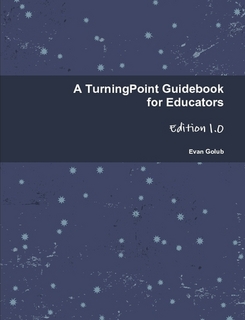
|
A TurningPoint Guidebook for Educators |

|
Evan Golub
(egolub@acm.org)
Department of Computer Science
Human-Computer Interaction Lab
University of Maryland

|
A TurningPoint Guidebook for Educators |

|
 |
A guidebook for faculty planning on, or interested in, using Turning Technology student response devices in their class. Includes some tips and tricks for getting started and examples of polling options provided by the TurningPoint plug-in. TurningPoint AnyWhere, ResponseCard AnyWhere, and report generation are also discussed. A free PDF version of this guidebook can be downloaded from Lulu Enterprises Inc. A printed and bound version of this guidebook can be bought from Lulu Enterprises Inc. or from Amazon.com |
Table of Contents
|
This page last modified on Friday, 08-Mar-2024 16:05:42 EST. |